
Quick Tips
- Prepare the room for clean walls.
- Prepare yourself to clean painted walls.
- Gather your gear and make homemade wall cleaner.
- Start cleaning walls.
- Rinsing clean walls.
- Drying your clean wall.
I’ve been bouncing from crappy rental property to crappy rental property about once a year for the last ten years. With a couple notable exceptions, every new place has been just a little bit better than the one before. One thing that never seems to change, however, is the condition of the walls upon arrival. It seems that we always somehow manage to rent the place that had been previously occupied by an untrained troupe of finger-painting, feces-tossing chimpanzees. Oh sure, they’re cute. But if you’d seen the kind of grease smears, hand prints, dirt, food splatters and monkey doody that I’ve had to clean off of walls before unpacking, you would understand my disdain.
The bright side of all of this is that, over the years, I’ve gotten pretty good at cleaning walls. In fact, I’ve even been able to convince a couple of people that it’s better, faster, cheaper and easier to clean walls than it is to take the “lazy” way out by simply painting over them. Once you get going on it, you’ll be amazed not only by how easy it is, but also by how much accumulated filth can be washed off with a good wall cleaning session. Don’t let me mislead you: just because it’s easy doesn’t mean it’s quick. You’ll want to allow yourself at least a couple hours per room. It’s important to know what your walls are painted with, too. If they’ve been painted with a gloss, semi-gloss or satin finish paint, you should be fine. If they’re painted with an old flat base paint, I wouldn’t recommend washing them. You could end up washing a bunch of the paint away.
How to Clean Painted Walls
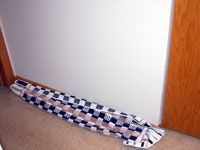 Prepare the room for clean walls. Before you delve too deeply into cleaning painted walls, do whatever you can to make the whole process go a little more smoothly. Start by removing all picture frames, mirrors, shadow boxes, etc. After that, pull any furniture away from the wall by at least four feet. Excellent. Now, before you wash walls, it’s important to dust them. It just makes the whole process easier. You won’t have to worry about grinding dust into the paint, your wall cleaner will stay cleaner longer, and if you get any drips they’ll be less likely to leave marks and easier to wipe off. Finally, run some old clean towels along the floorboards to catch water.
Prepare the room for clean walls. Before you delve too deeply into cleaning painted walls, do whatever you can to make the whole process go a little more smoothly. Start by removing all picture frames, mirrors, shadow boxes, etc. After that, pull any furniture away from the wall by at least four feet. Excellent. Now, before you wash walls, it’s important to dust them. It just makes the whole process easier. You won’t have to worry about grinding dust into the paint, your wall cleaner will stay cleaner longer, and if you get any drips they’ll be less likely to leave marks and easier to wipe off. Finally, run some old clean towels along the floorboards to catch water. Prepare yourself to clean painted walls. I know it sounds kinda hokey, but it really is best to go into this with a plan of action firmly in mind. The first thing you should do is to look at the walls you are cleaning, decide which order you want to do them in, and pick the point where you will begin to wash walls (usually a corner or the beginning of a wall). Next, stand back, look at your dirty walls and imagine them split into horizontal thirds with a top, middle and bottom. This is done because,when the time comes for washing wall sections, you will be doing it one third at a time.
Prepare yourself to clean painted walls. I know it sounds kinda hokey, but it really is best to go into this with a plan of action firmly in mind. The first thing you should do is to look at the walls you are cleaning, decide which order you want to do them in, and pick the point where you will begin to wash walls (usually a corner or the beginning of a wall). Next, stand back, look at your dirty walls and imagine them split into horizontal thirds with a top, middle and bottom. This is done because,when the time comes for washing wall sections, you will be doing it one third at a time.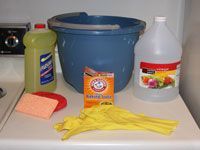 Gather your gear and make homemade wall cleaner.For this little exercise you will need two buckets, two clean sponges or rags, a pile of clean dry towels, rubber gloves, and some cleaning products. Fill your first bucket with a gallon of warm (not hot) water and mix in one cup vinegar, one cup ammonia, and 1/4 cup baking soda. Put on your rubber gloves and stir it all up. Fill your second bucket about 2/3 full with fresh, clean, warm water. This is your rinsing bucket. Now carry all of your stuff into the room where you will begin to wash wall sections.
Gather your gear and make homemade wall cleaner.For this little exercise you will need two buckets, two clean sponges or rags, a pile of clean dry towels, rubber gloves, and some cleaning products. Fill your first bucket with a gallon of warm (not hot) water and mix in one cup vinegar, one cup ammonia, and 1/4 cup baking soda. Put on your rubber gloves and stir it all up. Fill your second bucket about 2/3 full with fresh, clean, warm water. This is your rinsing bucket. Now carry all of your stuff into the room where you will begin to wash wall sections.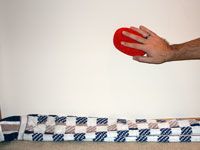 Start cleaning walls. First, make sure your rubber gloves are on and roll the tops of them down so that when your hands are above your head, water will roll into the cuff instead of up your arm. For further protection from running water, put on a couple sweat bands or cut the toes out of an old pair of socks, put your arm through the hole, and push the socks up to your elbows. Now, grab one of your sponges, dip it into your cleaning solution, and, starting at the bottom third of the wall (trust me), start wiping. Only wipe as far as you can reach while standing still. You don’t want to clean too big of a space at once. Make sure you don’t miss any spots. If you do, they will show up when the wall is dry. I say to start at the bottom because it is much easier to remove drip marks from a clean wall than it is a dirty wall. So when you’re cleaning the upper two-thirds and water drips down, it will be much easier to wipe off.
Start cleaning walls. First, make sure your rubber gloves are on and roll the tops of them down so that when your hands are above your head, water will roll into the cuff instead of up your arm. For further protection from running water, put on a couple sweat bands or cut the toes out of an old pair of socks, put your arm through the hole, and push the socks up to your elbows. Now, grab one of your sponges, dip it into your cleaning solution, and, starting at the bottom third of the wall (trust me), start wiping. Only wipe as far as you can reach while standing still. You don’t want to clean too big of a space at once. Make sure you don’t miss any spots. If you do, they will show up when the wall is dry. I say to start at the bottom because it is much easier to remove drip marks from a clean wall than it is a dirty wall. So when you’re cleaning the upper two-thirds and water drips down, it will be much easier to wipe off.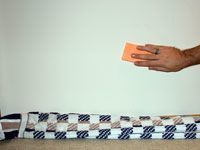 Rinsing clean walls. After you’ve cleaned your first section of wall, immediately rinse it. Do this by dropping your second sponge into your second bucket (the one with fresh warm water). Pull the sponge out, ring it out nicely, and gently wipe the cleaning solution off the wall. You may need to re-dip your sponge a time or two. Take your time and do a good job with this.
Rinsing clean walls. After you’ve cleaned your first section of wall, immediately rinse it. Do this by dropping your second sponge into your second bucket (the one with fresh warm water). Pull the sponge out, ring it out nicely, and gently wipe the cleaning solution off the wall. You may need to re-dip your sponge a time or two. Take your time and do a good job with this.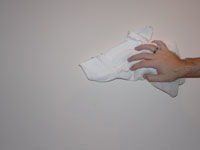 Drying your clean wall. After the wall section has been washed and rinsed, immediately wipe it down with a towel from the pile you grabbed earlier. After you’ve washed, rinsed, and dried the first section of wall, move up to the middle section and do the same. Then move to the top. Keep one towel on your shoulder at all times. This will help you control the drips that will come down from washing the higher sections of wall. I would strongly recommend that, after you’ve completed your task and have shiny, clean painted walls, you reward yourself with at least one adult beverage.
Drying your clean wall. After the wall section has been washed and rinsed, immediately wipe it down with a towel from the pile you grabbed earlier. After you’ve washed, rinsed, and dried the first section of wall, move up to the middle section and do the same. Then move to the top. Keep one towel on your shoulder at all times. This will help you control the drips that will come down from washing the higher sections of wall. I would strongly recommend that, after you’ve completed your task and have shiny, clean painted walls, you reward yourself with at least one adult beverage.
More Tips for How to Wash Walls
Most walls with wallpaper can be washed with the same method mentioned above. Before washing wallpaper, make sure that it is safe to do so. Most wallpapers are made with vinyl and clean quite well; others, however, are not, and can be ruined if washed incorrectly. If you are uncertain, try it first in a small inconspicuous area.
- Do not wash walls with TSP! It is simply unnecessary. TSP (trisodium phosphate) can cause health problems such as burns on the skin, blisters, coughing, and eye irritation. It also damages the environment through the addition of phosphates into waterways.
- Dust your walls regularly. A little preventative care now can save you a lot of time in the future. Dust them down about once every other month.
- Remove crayon from walls by rubbing it lightly with a damp rag dipped in baking soda.
- Crayon can also be removed from walls by shooting it briefly with a warm blow dryer and wiping the melted wax with a baby wipe.
- To clean off walls that have ink stains, dump a little rubbing alcohol on a rag, place the rag on the ink stain, and gently dab until the stain is gone.
Wall Cleaning Tools
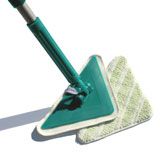 Wall mops.These great tools are available at most janitorial supply shops and most big box stores. They’re super easy to use and can really speed up the process of cleaning walls. Besides shortening your wall cleaning time, they also save you the pain that comes from holding your arms over your head for extended periods.
Wall mops.These great tools are available at most janitorial supply shops and most big box stores. They’re super easy to use and can really speed up the process of cleaning walls. Besides shortening your wall cleaning time, they also save you the pain that comes from holding your arms over your head for extended periods.
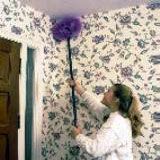 Big Wally Brushes. Same idea here as with the mop I mentioned previously. Using one of these tools to dust off your walls will make the job much faster and, therefore, make it far more likely that you will actually keep up on it.
Big Wally Brushes. Same idea here as with the mop I mentioned previously. Using one of these tools to dust off your walls will make the job much faster and, therefore, make it far more likely that you will actually keep up on it.
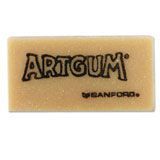 White vinyl or art gum erasers.These are something that everyone should have a few of for around the house. They work well for removing dirt, smudges, pencil, crayon, and even dried-on cooking grease from walls. They cost less than a buck and can be purchased from damn near anywhere. In fact, I bought one from your mom just last week. Or you can order Art Gum erasers from Amazon.
White vinyl or art gum erasers.These are something that everyone should have a few of for around the house. They work well for removing dirt, smudges, pencil, crayon, and even dried-on cooking grease from walls. They cost less than a buck and can be purchased from damn near anywhere. In fact, I bought one from your mom just last week. Or you can order Art Gum erasers from Amazon.